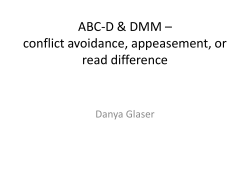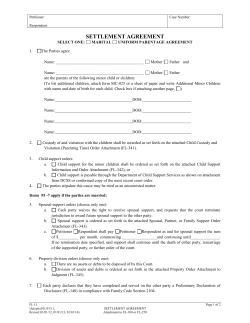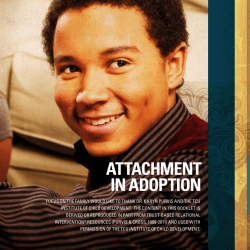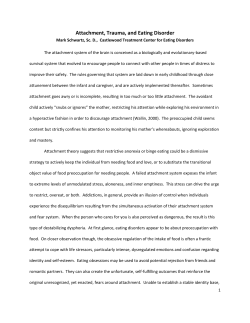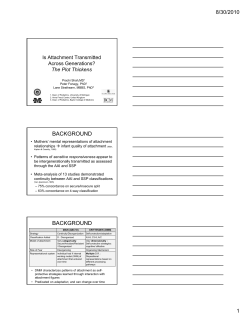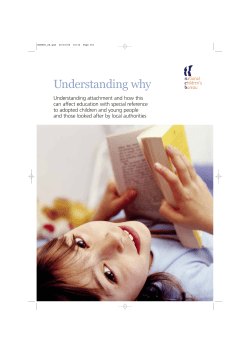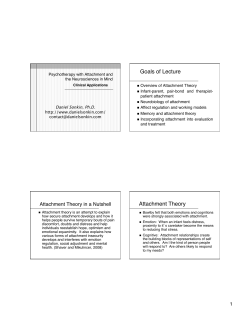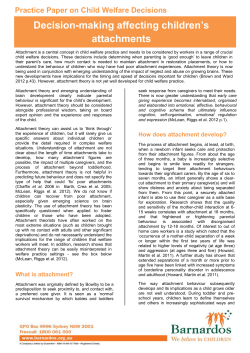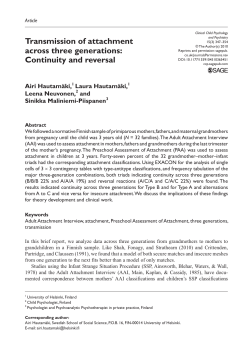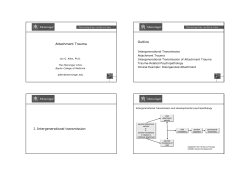
Legal Aid NSW Family Law Conference, Sydney, August, 2011
Legal Aid NSW Family Law Conference, Sydney, August, 2011 Parenting arrangements for the 0 - 4 year age group Federal Magistrate Robyn Sexton Parenting arrangements for the 0 - 4 year age group Federal Magistrate Robyn Sexton, Federal Magistrates Court Sydney Registry Conference Hanoi, Vietnam, 13-15 September 2011. Abstract As practitioners in family law, we try to minimise the negative impact of family breakdown on children and we try to maximise children’s chances of healthy development. This paper is about the special difficulties we face when the subject child is in the 0-4 year age group. My focus is a list of questions, to which I, and others I have consulted in the social science field, believe we need answers before deciding on parenting arrangements which will best promote the interests of that child. The literature tells us that the period from birth to about 4 years, is a massive developmental stage when a child’s attachments are established. Children of this age group are especially vulnerable to disturbance in the development of their attachments to their primary carers. Failure to protect the development of healthy secure attachments in a young child can have profound long term negative effects on the development of that child. In the Family Law Courts, we are seeing a great number of cases involving this age group, and since the amendments in 2006 to Part VII of the Family Law Act 1975, we are seeing an increasing number of cases in which a parent is seeking equal or substantial and significant time arrangements, whether or not the child is in this young age group. The social science literature can be confusing as opinions in this area differ. There is no reliable framework to which practitioners and judicial officers may refer. Vexed questions arise in relation to overnight arrangements, relocations and when what appear to be inappropriate parenting plans agreed by parties are submitted to the court for rubber stamping. However, there are guidelines that can be used to work through the difficult questions which arise in cases involving the 0-4 age group, and this paper is an attempt to provide a practical approach to working out what is best for that child. Introduction 1. Hot off the press is a Special Issue of Family Court Review, published by the Association of Family and Conciliation Courts (AFCC) in the USA in July 2011, called “Special issue on Attachment, Separation, and Divorce: Forging Coherent Understandings for Family Law”. This is such an important area that an entire edition of this leading family law journal has been devoted to it. In it, the well known social scientist, Carol George says this1: I do not know many other things that evoke such strong feelings in people than the combination of divorce, custody, and babies. Parents, attorneys, judges and everyone around the baby can be very stirred up. 2. In my experience, the same applies equally when young children are involved. 3. Sir Richard Bowlby, the son of the attachment theory architect, John Bowlby, says 2: …optimal outcomes for most children do not start with separated parents. The question … is ‘how can you achieve a tolerable outcome for children of a separation or divorce? 4. What is in the best interests of a child in this 0-4 year age group? Should the Court make an order for equal time for a 9 month old? Should an 18 month old, with recently separated parents, be permitted to relocate with her mother from Sydney to Cairns? Should the Court make an order for a 3 year old to travel between Sydney and Melbourne each fortnight so he can spend equal time with each parent, until he starts school? If the answer is No, then why not? And does the question depend solely on the age of the child? 5. My aim is to highlight some of the questions I believe we, as lawyers and decisionmakers, need to ask ourselves when faced with these issues because we see a lot of cases in which a child in this young age group is the subject of the proceedings. The child‟s parents have either separated early in the child‟s life, or, not uncommonly, the parents have never lived together at all. 1 George, C, Solomon, J, & McIntosh, J, (2011), “Divorce in the Nursery: On Infants and Overnight Care”, Family Court Review, 49(3), 521-528 at 521 2 Bowlby, R & McIntosh, J (2011), “John Bowlby‟s Legacy and Meanings for the Family Law Field: In Conversation with Sir Richard Bowlby”, Family Court Review, 49(3), 549 – 556 at 549 2 6. In addition to decisions required from the Bench, there are parenting arrangements agreed between parties which the court is asked to approve. I‟m now at the end of my 7th year as a Federal Magistrate, and it has been 5 years since the amendments to Part VII of the Family Law Act 1975 were introduced. I am troubled by the number of cases I see in which young children have been the subject of parenting agreements or orders, which seem to me, from my reading and discussions with experts in this area, to be inappropriate for their developmental stage and their particular circumstances: agreements or orders which are likely to cause avoidable (and sometimes irreparable) damage to that child. 7. The experts tell us that repetitive stress is not good for young children – it puts at risk their sense of the world being a safe and secure place, and can lead to anxiety and even depression. If a young child is difficult to settle, clingy or withdrawn for prolonged periods, either in the non-resident parent home or on return to the resident parent, it is highly likely that the infant is overly stressed3. Repetitive stress can lower a child‟s stress threshold, so the tiniest thing will upset the child. There might be nightmares, regressive behaviours such as bed wetting in a toilet trained child, excessive clinginess, frequent tears, unexplained aggression, poor appetite, or uncharacteristic behaviours such as a general loss of enthusiasm for play. 8. I will briefly refer to some academic work on this topic: in particular, a very recent paper by Judy Cashmore and Patrick Parkinson, academics from Sydney University who will be well known to some of you. This paper will soon be published in the Australian Journal of Family Studies. I also refer to a couple of cases which have been before me, where I have had the benefit of a report from an attachment expert, Dr Louise Gyler, a child and adult psychoanalyst in Sydney. 9. I have always had a strong interest in the welfare of children but today I speak solely from my position as a Federal Magistrate, not as a social scientist or academic on the topic. Why 0-4? 10. The literature says that the period from birth to about 4 years, is a massive developmental stage both neurologically and behaviourally when a child‟s 3 attachments are established. I recommend the interview between Dr Jennifer McIntosh and Dr Allan Schore4 in which the astonishing brain development of the early years of life is described with its effect on attachment capacity. It seems generally accepted that serious disruption to the child‟s primary attachments can lead to adverse outcomes including subsequent mental health issues throughout that child‟s life span. The research suggests that sometime around 3 or 4 or a bit older, children become less troubled by separations from the primary attachment figure as the infant brain takes on the adult configuration. We certainly know from the literature that children up to about 4 years of age cannot regulate their own emotions without the assistance of an attachment figure. In a recent study, McIntosh, Smyth and others talk about the age of 4 as a time when a child can manage straddling households5. Cashmore and Parkinson focus their paper on children under 4. These are the reasons I have adopted the period 0-4 years for my discussion today. 11. Personally, I find decision making about parenting arrangements for children under 4 years, difficult. The court is often confronted with self represented litigants, or with lawyers who appear to have given limited thought to the area. We don‟t always have family reports, particularly at the interim stage, and rarely an expert report at all, because of financial constraints, and in cases involving young children, the children are, of course, too young to assist us in any direct way. In an ideal world, from the child‟s perspective, we would have an attachment expert to help us in every case involving this age group. Even that would have its limitations, given the differences in views amongst the social scientists as to what attachment theory is really telling us, and how it should be applied in parenting cases involving little children. 12. Of course the court must apply the legislation and you must advise your clients with the legislation firmly in mind. Somehow, the introduction of the 2006 amendments, despite a continuation of the best interests principle, has created an expectation in many in the community, both within and without the broad family law system, that when the presumption in favour of equal shared parental responsibility applies, an outcome of equal time or substantial and significant time will follow, without careful 3 Lodge, P, (2010) DRAFT Paper - Attachment Theory and Decision Making in the Family Law Context: A Practice Perspective, Family Consultant Sydney Registry of the Federal Magistrates Court, unpublished, at page 7 (hereinafter referred to as the “Paul Lodge paper”) 4 Schore, A, & McIntosh, J, (2011), “Family Law and the Neuroscience of Attachment: Part 1”, Family Court Review, 49(3), 501 - 512 at 501 4 regard to the age of the child/children, the quality of parenting, or that child‟s particular circumstances. From the recent Australian Institute of Family Studies (“AIFS”) evaluation of the 2006 reforms6, we know that the proportion of children with separated parents who experience shared care arrangements (i.e 5 or more nights a fortnight) increased after the July 2006 changes were introduced and that the increase is especially marked among families whose disputes were finalised through judicial determination. We know from that study7 that a significant proportion of both fathers and mothers in the 2009 survey believed that spending approximately half the time with each parent can be appropriate, even for children under 3 years of age. 13. There is, of course, nothing in the Act that says sections 63DA which deals with your obligations as advisers, and 65DAA8 (circumstances in which a court must consider equal or substantial time) are confined to children of school age or above school age. In my experience, there is therefore considerable pressure on all of us, at times, to either seek orders or in the Court‟s case, make orders, which may, if made, cause a disruption to the healthy development of a child‟s secure attachments, and/or cause a damaging level of stress in that child with adverse physical and psychological consequences long term. 14. This misunderstanding in the community about what the legislation really says has also led to some primary care givers entering into agreements, (doing deals), for fear of getting a worse result for their child in a Court, even when that caregiver believes or knows that that child is unlikely to be able to emotionally manage what they‟ve agreed to. On many occasions, when I have had concerns about the appropriateness of consent terms for a child under 4, and have checked the view of the primary carer directly in the Court room, I have been told the party, (usually the mother) doesn‟t think it will work, but has signed the terms, either to relieve pressure from the other side, to get out of the Court system, to avoid any accusation of not being a parent who facilitates time, or to ensure the Court is not given the opportunity to make it even worse for the child, as the party may have been warned. 5 McIntosh, J., Smyth, B., Kelaher, M., Wells, Y., Long, C, (2010) Post-separation Parenting Arrangements and Development Outcomes for Infants and Children, Report to the Australian Government Attorney-General‟s Department, Family Transitions, at page 9 6 Kaspiew, R., Gray, M., Weston, R., Moloney, L., Hand, K., Qu, L., and the Family Law Evaluation Team (2009) Evaluation of the 2006 Family Law Reforms, Australian Institute of Family Studies, Melbourne (hereinafter referred to as the “AIFS Report”) 7 Ibid at page 116 8 Family Law Act 1975 5 15. I‟m not offering a silver bullet. And you will not necessarily agree with what I say. This is a discretionary area for the Court. My purpose is simply to raise some of the issues and to suggest a list of questions to have in our minds when we are dealing with a matter involving a child under 4. Attachment theory 16. We need a working understanding of the concept of attachment theory, as it will be used by the experts who prepare reports and appear in Courts. Attachment theory is central to any discussion about age appropriate orders for babies and young children. It is the theory and research tradition of Bowlby and Ainsworth. There is a mass of literature about it spanning the last 50 years. Its complexity as far as application to the family law context is concerned, is evident in the articles in the Family Court Review Special Edition I have referred to. McIntosh says 9 in her interview with the son of the creator of the theory, Sir Richard Bowlby: McIntosh says: My observation is that curious versions of attachment theory are sometimes recruited to support family law decisions. Sir Richard responds: I get somewhat heated about these misinterpretations of attachment theory, because it leads to things such as a young child being ordered to spend a month in one place with one parent, and then a month with the other parent … which is a form of madness. …. King Solomon had the problem, now the judges have got it. 17. While most of us are unlikely to be, or to become experts in the area, we at least need to know who is the primary attachment figure and who are the other attachment figures for security and comfort – who would the child naturally turn to for comfort? Who provides a safe haven or a secure base for that child? Robert Marvin, a pre-eminent attachment expert from the US, says10: 9 Bowlby, R & McIntosh, J , above n 2, 553 Byrne, J, O‟Connor, T, Marvin, R & Whelan, W, (2005), “Practitioner Review: The contribution of attachment theory to child custody assessments”, The Journal of Child Psychology and Psychiatry, 46(2), 115 -127 10 6 …young children are not designed to cope with the separation from their parents and alternating between two different homes… ..parental separation is a powerful challenge to the child’s attachment relationships with the Mother and the Father.. 18. Paul Lodge explains that from a few weeks of age until about 5-9 months an infant‟s preferential attachment to caregivers (usually but not always parents) evolves.11 By about 5-9 months a child‟s clear cut attachments have formed and thereafter stranger wariness and separation anxiety will be a feature of a child‟s attachment behaviours until 3-4 years of age. A child can have more than one attachment but it will be a small number and those attachments will most likely be hierarchical. 19. We know that healthy attachments are critical to a child‟s functioning and future.12 We know that inappropriate parenting arrangements can negatively impact on both the continuity and the quality of the child‟s attachment relationships and cause disruption to the development of a secure attachment with both the primary parent and the parent with whom the child is going to spend time. 20. Evelyn Clark, a United Kingdom child psychologist whose lecture to family law Judges I attended last year, explains that attachment is a biological drive, and that the satisfaction of that drive is even more vital to the infant than hunger and thirst13. Ms Clark says: It is an adaptive mechanism, designed to keep a carer in close proximity to an infant in order to ensure the survival of that child…The infant is preprogrammed with a repertoire of behaviours that will maintain the proximity of the parent and can signal distress in order to gain attention… crying, cooing….reaching out, etc. It is equally important that the carer is preprogrammed to respond swiftly…The adult behaviours include being mentally and physically available to the infant, sensitive to his/her needs, attuned to his/her emotions…The intensity of this drive is such that a failure to satisfy it rouses powerful negative emotions in the infant14. 11 Lodge, P (March 2010) Seminar to Family Law Practitioners Clark, E, “The Assessment of Attachments”, (Paper presented at the Judicial Conference Northampton, United Kingdom, May 2010) 13 Ibid at page 2 14 Ibid at page 2 - 3 12 7 21. Evelyn Clark notes that the absence of a primary caregiver need only be threatened, to be sufficient to cause deep fear and anxiety in a young child. If that situation is sustained and there is an on-going failure to meet the child‟s emotional needs, then the child will experience a heightened state of tension and anxious arousal with a subsequent negative and sometimes profound effect on development15. 22. A research study in 2010 by Humphreys and Kiraly concerning children in foster care, found that while brain development begins in utero, it is only 25% of its adult size at birth; yet by 3 years it is 90% of adult size. … the child’s cognitive, behavioural and emotional development is dependent upon the way in which the different parts of the brain develop, which will be compromised in the absence of a secure attachment16. In extreme cases, like the children found in orphanages in Eastern Europe, the lack of emotional care in infancy was so destructive that those children actually had smaller brains. 23. So when looking at parenting arrangements, we need to ensure that we are maximising the chance for that young child to maintain healthy attachments. At a seminar last year, Paul Lodge said that the twin goals of the Courts when considering parenting schedules for young children is both relief from attachment stress and promotion of attachment repair.17 24. A securely attached child can use the parent as a platform for exploring the world. For a secure attachment, the parent must be attuned to the child‟s attachment cues. 25. From time to time, the Court has commented on the importance of the Court taking attachment issues into consideration18. The issue arises squarely when a parent of a young child seeks to relocate. Empirical studies – what do they tell us? 26. Cashmore and Parkinson comment on the lack of empirical studies specifically concerned with infants and young children19. They note that the level of 15 Ibid at page 3 Humphreys, C., Kiraly, M., (2010), “Developmentally sensitive parental contact for infants when parents are separated”, Family Matters, (85), 49-59 17 Lodge, P, above n 11. 18 See for example Morgan & Miles [2007] FamCA 1230 per Boland J; McCall & Clark [2009] FamCAFC 92 per Bryant CJ, Faulks DCJ and Boland J; Starr & Duggan [2009] FamCAFC 115 per Boland, Thackray and Watts JJ; Benelong & Elias [2009] FamCA 1312 per Watts J; Vogel & Abell [2010] FMCAfam 1189 per Halligan FM 19 Cashmore, J & Parkinson, P, (2011) DRAFT Paper - “Parenting Arrangements for Young Children” 16 8 disagreement between clinicians and researchers can lead to confusion for judges, practitioners and mediators on how to apply the research evidence in reaching decisions for this age group. They point out that when parents separate, the overwhelming majority of infants and young children in Australia live with the mother, reflecting women‟s greater role in the care of young children in most intact families. This means that separated fathers are generally non-resident parents who want and need time with their young children to establish or maintain meaningful relationships with them20. Cashmore and Parkinson identify a number of developmental considerations: these are “children’s developing attachments, their limited sense of time, and their increasing capacity to tolerate separations as they get older.”21 They address three questions: i) first, at what age and in what circumstances is it appropriate for this age group to stay overnight with the non-resident parent? ii) second, when, if at all, is it appropriate to make arrangements for substantially shared care between parents of this young age group? iii) And third, what orders should be made when there is long distance between the young child‟s parents? 27. The vexed question of overnight stays. In my experience, and I expect in yours too, this issue attracts a great deal of emotion and angst. The applicant (mostly the father) is convinced that nothing less than overnight time will be enough. And why shouldn‟t he have overnights, whatever the circumstances? He‟s as good a parent as she is. The respondent, (usually the mother) is often distraught with apprehension as to how the child would cope with overnights, given the father‟s lack of skills and experience as a parent. And anyway, they loathe each other. What does the social science tell us we should do? 28. According to respected social scientist, Judith Solomon22 “we have some good indications now that weekly overnights are too much of the wrong kind of contact for many young children….there is a special vulnerability about night time. The state of the organism is to be more anxious at night. That is hard-wired in our cortisol rhythms”. 20 Ibid Ibid 22 George, C, Solomon, J, & McIntosh, J, above n 1, 524. 21 9 29. However, there are different views. Cashmore and Parkinson say “there has been vigorous debate between respected researchers and clinicians about the value or harmfulness of infants staying overnight with their father.”23 30. Cashmore and Parkinson closely analyse the relevant studies and conclude that “the available research does not support the view that overnight stays for very young children are per se, problematic”. However, they conclude on the basis of research, that while each case depends on its own circumstances, certain factors do emerge as important. 24 31. McIntosh, Smyth et al produced a report for the Attorney-General‟s Department in May 2010 called “Post separation parenting arrangements and developmental outcomes for infants and children.”25 They explore the relationship between frequent overnights with the non-residential parent and the emotional development of these young children. 32. The authors say inter alia26: Young infants under two years of age living with a non-resident parent for only one or more nights a week were more irritable, and were more watchful and wary of separation from their primary caregiver than young children primarily in the care of one parent. Children aged 2-3 years in shared care (defined as 5 or more nights a fortnight) showed significantly lower levels of persistence with routine tasks, learning and play than children in the other 2 groups…they also showed severely distressed behaviours in their relationship with the primary parent …consistent with high levels of attachment distress… this is apparently a period when children‟s separation anxiety and stranger wariness is at its highest. Behaviours reported included crying or hanging on to the parent when he/she tried to leave; not reacting when hurt; often becoming very upset; gagging or choking on food; hitting, biting, kicking parent. 23 Cashmore, J & Parkinson, P, above n 19. Ibid 25 McIntosh, J., Smyth, B., Kelaher, M., Wells, Y., Long, C, above n 5. 26 Ibid 24 10 Thus, they concluded that regardless of socio-economic background, parenting or inter-parental cooperation, shared overnight care of children under 4 years of age had an independent and deleterious impact on several emotional and behavioural regulation outcomes. … once between 4-5 years, those effects were no longer evident. So can better manage movement between households in a frequently shared overnight arrangement. 33. McIntosh says27 that she is “conservative about equal shared overnight care prior to age 6”. 34. Critical of the McIntosh study in a number of respects, Cashmore and Parkinson 28 helpfully summarise what they say the research findings tell us29. There is some evidence for an adverse effect of care arrangements that take under 2‟s and 2-3 yr olds away from their primary carer overnight. They say there is some evidence for an adverse impact of shared care arrangements for children under 4. In particular, they say that the McIntosh study highlights the risks associated with shared care arrangements involving 5 or more nights per fortnight with each parent for under 4‟s. But they conclude that overall what matters is “the degree of warmth and responsiveness of parents (especially mothers), the level of communication and cooperation, and hostility between the parents, and the importance of the continuity and consistency of the care arrangements and the number of other caregivers the children have.” The following is the ideal30 (not often seen in the context of our work): i) Both parents have a secure and warm relationship with the child before separation; ii) The mother is supportive of the father/child relationship, including expressive positive feelings and reassurance on handover and reunion; iii) Routine is consistent and predictable and the child not away from the other parent more than a few days at a time; iv) No conflict in front of the child or conveyed in any way to the child; 27 George, C, Solomon, J, & McIntosh, J, above n 1, at 525. Cashmore, J & Parkinson, P, above n 19. 29 Ibid 30 Ibid 28 11 v) Both parents communicate and monitor the child‟s tolerance for the separations. Any increasing contact should be gradual with continuing sensitivity to the child‟s reactions and behaviours. Distress at changeover needs to be managed sensitively by both parents. Transitions handled in a negative way will increase the child‟s stress. Must be able to repair a disruption to create a secure attachment. So what are the questions we need to ask in these cases? 35. What do we need to bear in mind given the realities of limited time, limited resources, the nature of distressed clients and the problems of self-represented litigants? I have created a list of questions from a number of sources, including discussions with Dr Gyler, Dr Judy Cashmore and Mr Paul Lodge (the trainer of Family Consultants in this area). I have also been assisted by an article by F.W. Norris (2007) in the Journal of Child Custody31. 36. What do we know about this particular child? How old is the child? A 3 month old raises different considerations from a 3 and a half year old. While it is generally accepted that children can manage greater periods of separation from the parent at the top of their hierarchy of attachment relationships, as they get older, we are told by Dr McIntosh et al that it is not a smooth trajectory.32 Children 2 and 3 years of age are particularly vulnerable and we know children cannot regulate their own emotions without the assistance of an attachment figure until they are about 4. Paul Lodge tells me that when he lectures fathers on this subject about young children and attachment theory he says, “Don’t force it; the child will remember that distress and become increasingly distressed when with you.” Paul reminds fathers that formation of secure attachment relationships has nothing to do with night and day. Regular daytime is perfectly adequate to develop a secure attachment relationship as many a grandparent will attest. Overnight stays are not critical to attachment formation. It will be important to ask whether any symptoms of stress, (behavioural changes etc) coincided with the commencement of overnights or more prolonged separations from the primary caregiver. 31 Norris, F, (2007) “ Decision-making criteria in child custody disputes that involve requests for overnight visits with infants and toddlers: Derived from a review of the literature”, Journal of Child Custody, 4(3-4), 33-43 32 McIntosh, J., Smyth, B., Kelaher, M., Wells, Y., Long, C, above n 5. 12 What are the particular traits of this child?: What is the child‟s temperament? How does this child cope with change? Easy going, resilient, robust or shy, anxious or an easily unsettled child. The question will be how long can this particular child‟s absence from an attachment figure be sustained before attachment formation will be damaged and/or the child will experience a sense of loss? What is the child‟s capacity for reflective functioning? Does the child have the capacity to form a clear plan with the parent (usually Mother) about the separation and reunion from and with that primary attachment figure. Children at aged 4 years are less dependent on physical proximity to, and contact with the primary caregiver in order to maintain a sense of security, provided they are in the care of responsible, caring adults33. They are therefore likely to be more capable of more time away from the primary attachment figure. Does the child have an older sibling transferring with him/her? Overnights appear to be easier for young children when they have an older sibling going with them to ease the transition. That relationship itself will be an attachment relationship. 37. What do we know about the quality of this child’s relationships with each parent? What is the nature of the relationship between the child and each parent? How old was the child when the parties separated? What kind of relationship are we building on? We know that if the child has at least one secure attachment, he/she is more likely to be able to cope with more time with the other parent. If a child is securely attached to both parents, then overnights may well be appropriate. If there is an attachment problem with one caregiver, then it is less likely that overnights will be appropriate. What were the arrangements pre-separation? If time with a parent has been sporadic or disrupted or even non-existent, be very cautious about more than very limited time away from the primary attachment figure, so probably no overnights. 38. What do we know about the relationship between the parents? 33 Marvin, R.S., & Britner, P.A. (2008), “Normative development. The ontogeny of attachment.” in J. Cassidy & P. Shaver” (Eds). Handbook of attachment: Theory, research and applications (pp.269-294) cited in McIntosh, J., Smyth, B., Kelaher, M., Wells, Y., Long, C, above n 5, 152. 13 Are they communicating well and listening to each other? Do they trust and respect each other as parents? If there is high conflict and an absence of communication, Solomon says34 it is not the time to start overnights because attunement to the needs of the child will be compromised. We therefore need to be particularly cautious when we have a combination of a young child and high conflict.35 Solomon also says36: In theory, older children, around four and over, can handle more stress, again because of this additional cognitive and emotional development. But they continue to be subject to what every child is subject to, which is that the stress of parent conflict, whether it is expressed or suppressed, is simply a great burden for a child. That burden remains important to consider. Parkinson and Cashmore refer to the Solomon and George 1999 study which concludes that “the extent to which mothers communicated with the father about the child was strongly associated with the child’s attachment to their father, indicating fathers may be dependent on approval from and communication with the Mother to establish a relationship with the child in the early years.” 37 What has been observed at changeovers? Because separation and reunion from and to an attachment figure will trigger attachment responses in a child, what happens at changeover is very significant, and the number of transfers in any given period will be significant. So we need to ask: how is the child managing transitions? How does the child behave before and after? How sensitive is the mother, or the resident parent, to the child‟s distress on separation and reunion? How willing are parents to cooperate and communicate in managing transitions for their child? Traumatic transfers place stress on the child‟s attachment system so repeated traumatic transfers for a young child will be very destructive - if the child is showing signs of prolonged distress, be very cautious. Of course, if parents are communicating well, transitions are unlikely to be a problem. 39. What is the quality of each party’s parenting? How sensitive is each parent to the child‟s needs? Can the parent maintain a consistent routine for the child in such areas as meal times, eating habits, bedtime, 34 George, C, Solomon, J, & McIntosh, J, above n 5, at 527 Ibid at 523 36 Ibid 35 14 bath time, sleeping habits, toileting. Of course, consistent routines are more likely to be achieved in 2 homes if the parents can talk to each other. What is each parent‟s capacity for reflective functioning? That is: can each parent think from the child‟s point of view? McIntosh says that the cornerstone of parental reflection, and security in attachment, is the parent‟s capacity to take the infant‟s perspective.38 Ask your client this question: what would you do, if your child was with you overnight, woke up distressed and couldn‟t be settled? If the answer is “pick up the phone, talk to the primary attachment parent to see if they can suggest anything, and if necessary, take the child back to that parent”. Such a response indicates that this parent can acknowledge the critical importance of the child‟s relationship with the primary attachment figure. At times the quality of a parent‟s parenting is such, that there is no benefit to the child of having a continuing relationship with that parent. What is each parent‟s motivation for seeking more time? Is it to control the other parent? Is it to pay less or no child support? For some, seeking more time is about sadness, dealing with the loss of the ex-partner and the family and family life by seeking more time with the child. Is the parent motivated by the child‟s needs, or by the parent‟s needs? What is the level of anxiety in the resident parent about the child separating? The greater the separation anxiety, the less likely overnights will work, as that parental insecurity may transfer to the child and to the parent‟s attachment behaviours with the child. What is the quality of the child‟s relationships with extended family members and are the step parents and other extended family members supportive emotionally of the child? Whether step-mother, aunt, grandparent, that person must have the capacity for sensitive timely responses to the child‟s attachment cues in an ongoing way. 40. How practical are the proposed arrangements for a child of this age? Of course, as Cashmore and Parkinson point out, what is practical may not be what is optimal for the child. There are a number of questions here. 37 Solomon, J and George, C (1999), “The development of attachment in separated and divorced families. Effects of overnight visitation, parent and couple variables” Attachment and Human Development, (1) as cited in Cashmore, J & Parkinson, P, above n 19. 38 McIntosh, J (2006), “Assessing Attachment Needs and Potential in High-Risk Infants”, Journal of Family Studies, 12(1), 57-72 15 What distance is the child required to travel? Distance is often an obstacle to frequent movement between two homes. It is unrealistic to expect a young child to manage long distance travel on a regular basis. I have seen some absurd applications in this regard. For example, parties seeking a consent order for a 2 year old to travel from Sydney to Wagga Wagga and return by car every second weekend – approximately 14 hours. Where would the time allocated be spent? Is it realistic for a parent to spend all day in a park when a child is 20 months and needs a sleep during the day? Ask where the time will be spent: in a shopping centre, or in a comfortable home? What are each party‟s working commitments, commuting times? Is the baby being breast fed? When does the child sleep during the day? How many caregivers are there? Is the child at day care during the week? Are there financial constraints? What would the child‟s weekly routine be under the proposed regime? Is that routine manageable for that particular child in all the circumstances? We need to keep in mind that a young child needs a regular unchanging predictable schedule across months – not multiple changes according to the needs or wishes of the parent. We know that inconsistencies in routine take their toll on children emotionally. A Family Consultant said in a case before me recently involving a 3 year old: I like to see a child happily settled in a regular routine and no problems to be emerging out of that over a substantial period before moving on to the next step, particularly when you’re talking about a very young child. 41. What mental health issues, drug or alcohol issues need to be considered? If a child is with a substance addicted parent, he/she is likely to be receiving unpredictable and inconsistent responses to his/her attachment cues. This is damaging to a child‟s development. For example, with a heroin addicted mother who is currently using: on one day she can respond to the child‟s cries lovingly and on 16 another, is angry and irritated at the same behaviour. That mother should not have any time with the child or limited time under controlled circumstances. Paul Lodge believes that the “substance dependent person” is potentially an attachment nightmare. 42. All these questions are designed to ensure the inquiry is child focussed rather than parent focussed. Interesting case examples 43. I want to turn to a couple of case examples where attachment was compromised unwittingly by the parents. They are anonymised cases from my docket and in both I was fortunate to have the benefit of a report from the attachment expert, Dr Louise Gyler. Case No 1: The Case of George 44. Parties both intelligent, both worked and used a nanny and day care to some extent. Parties separated when their only child, George was 7 months. At separation, they voluntarily worked out a shared arrangement from the outset, which changed according to their work schedules and other commitments. So there were multiple transfers each fortnight and sometimes multiple transfers each week. The case came before me when the child was a bit over 2 years so this arrangement had gone on for about 18 months when first before the court. There was poor communication between the parties and a moderate level of conflict. George was presenting with a range of problems, resisting changeover, excessive crying, so the Mother initiated proceedings seeking that George live primarily with her. The Court obtained a report from Dr Gyler. After observations and consultations with the parties on approximately 4 different occasions, she found that George‟s attachment relationships had been compromised. Dr Gyler said in her report: George presented as a distressed and very anxious boy who exhibited aggressive and disruptive behaviour, including crying for extended periods. This is on background of parental relationship conflict, multiple transitions between parents who separated when George 7 months of age. George has not established object constancy and it is for this reason he appears not to register the absence of a parent. Object constancy refers to child’s capacity to retain a stable and integrated mental image of the continuous existence of his 17 caregiver when that person is physically absent. The development of this capacity enables children to manage emotionally, separations from their caregivers… 45. She recommended a minimal number of transitions, changeovers to occur in the mornings when the child was most resilient, taking the child out of day care, personal supervision only by the parent who had him (in other words no nannies) with the aim of trying to repair his attachments. She said neither party should take holidays to disrupt the arrangements until the primary relationship was repaired and then preserved and she recommended various quite specific therapeutic interventions. In her view, a lot of damage had been done. Her recommendations were focussed on repairing/improving the quality of his attachments. The child had an insecure attachment with each parent. George was in trouble. Red lights were flashing. Those changes were implemented, and the child‟s levels of stress diminished markedly. Case No 2: The Case of Angela 46. Girl Angela aged exactly 3 years. There were a number of separations between the parents from when she was 1 month old to when she was nearly 2 years. At 2 years, 1 month, the parties between themselves instituted an equal week about arrangement. They then introduced one night with the other parent in the off week for a while because the child did not appear to be coping. Changeovers occurred at the child‟s day care. The parents lived close by each other but there was poor communication. Angela presented with signs of both controlling and fearful behaviour. The Father wanted the shared arrangement essentially to continue. The Mother wanted primary care with her and limited day time to the father on weekends. The assessment of Dr Gyler was that Angela was primarily attached to her mother but the relationship was marked by fear and loss for Angela. The assessment was that Angela was showing signs of disorganised attachment behaviour which is characterized by fear and associated with longer term adjustment difficulties. She recommended equal time stop immediately and the child live primarily with the Mother. She said: With very young children it is a challenge to develop care arrangements that both provide security and continuity with a primary care giver so that object 18 constancy … can be established, as well as provide sufficient time with the other parent. 47. In the 2 case examples I have given you, the parties made arrangements according to their wishes and needs, not according to the needs of the child. This was despite the parties probably being well motivated and believing they were doing the right thing. Parents need to adapt themselves around these young children, not the children around the wishes or needs of the parents. The Law 48. Section 60CA of Part VII says we must make a decision in a child‟s best interests. Section 65DAA(5) requires us to consider „reasonable practicality’ when we are considering equal or substantial time arrangements. This requires us to consider communication issues and the impact such an arrangement would have on the child. But in a specific age related sense, apart from the reference to “the likely effect on the child of any separation from either or his or her parents”39 and the reference to “maturity”40 and “any other characteristics of the child the court thinks are relevant”41 in the section 60CC(3) additional factors, there is nothing in Part VII that requires us to focus specifically on the development needs of young children when making decisions. 49. Interestingly, in the AIFS evaluation42 legal sector professionals viewed that the legislative changes had promoted a focus on parents‟ rights rather than children‟s needs, obscuring to some extent the primacy of the best interests principle. Further, legal sector professionals said that the legislative framework did not adequately facilitate making arrangements that were developmentally appropriate for children. 50. Be mindful of the pressure you are under to fight for a bigger share of time right now, and tell your client not to expect parenting arrangements for a young child to remain the same throughout the child‟s life.43 The law encourages each parent to fight for a bigger share of their young child‟s time now, because unless they do, legally, it will be harder to get more time later. Remind parents of their need to 39 Family Law Act 1975, section 60CC(3)(d) Ibid, section 60CC(3)(g) 41 Ibid, section 60CC(3)(m) 42 Kaspiew, R., Gray, M., Weston, R., Moloney, L., Hand, K., Qu, L., and the Family Law Evaluation Team, above n 6 at page 24 40 19 adapt and work together to allow for flexibility as that child‟s needs change. Dr McIntosh says:44 Enabling responsiveness to changing needs is something that family law is not very good at. In my experience, court ordered arrangements tend too often to be rigidly locked in, and not reviewed frequently enough. My research…. has shown this to be highly problematic over time for children. Conclusion 51. As judicial officers and as practitioners, we can be under a lot of pressure to focus on the wishes of one or other parent, give a bit to him, and a bit to her, make it “fairish” for the parents, even to go some way towards ensuring a meaningful relationship with both parents as directed by the Act. We can therefore easily make orders or seek orders for arrangements which do not take into account the special needs of this young age group. In my view, we need to go further than just rubber stamping an agreement between parents, to ensure the decision is child, rather than parent focused. That will mean ensuring that attachment issues and that child‟s particular circumstances have been properly taken into account – in exactly the same way as we must have regard to the impact of family violence when crafting orders. 52. We should take heed of Cashmore and Parkinson45 when they say: In this difficult area, there is no room for decision-making that is driven by a concern for parental rights or fairness between parents. .. it may often not be possible to devise post separation parenting arrangements that are optimal for young children, but at least, we should aim as far as possible, to protect vulnerable young children from paying the price for adult notions of justice. 53. So in conclusion I suggest As family lawyers, we need a working understanding of attachment theory. 43 As noted by McIntosh, J, “Guest Editor‟s Introduction to Special Issue on Attachment Theory, Separation, and Divorce: Forging Coherent Understandings for Family Law” Family Court Review, 49(3), 418 -425 44 Bowlby, R & McIntosh, J (2011), above n 2, at 553 45 Cashmore, J & Parkinson, P, above n 19. 20 A child in the 0-4 age group needs special attention and a careful examination of what is happening to and around that child. Be cautious about overnight stays of more than 1 night a week for children under 4 years of age46 but also look carefully at the particular circumstances of that child. Consider the practicalities of what is being proposed. Remain focussed on the needs of the child. A colleague of mine told me of how the focus in a case before her changed remarkably when she asked to see a photo of the child, and sometimes I now ask for a photo. Hand the photo around to the lawyers, and to the parties, and remind everyone that this case is about this child in the photograph and that it is on this child that we must focus our attention. 46 Ibid 21
© Copyright 2025
